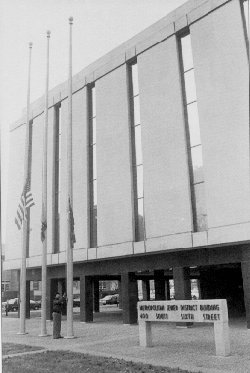As MSD’s challenges and programs grew, so did its staff and its requirements for space. For years, MSD had rented space in downtown buildings for its headquarters; this arrangement was becoming increasingly cramped and inefficient.
Early in 1965, MSD proposed building a $450,000 headquarters on land at Bowman Field. Within weeks, the proposal was changed: a larger headquarters building in the downtown government center, being developed under Urban Renewal, with extra space to be rented to other government agencies. In 1968, MSD moved into its new $1.9 million, four-story building at 400 S. Sixth St. The building would serve the agency for the next 27 years.
In 1967, as the new headquarters was being built, MSD consolidated its maintenance facilities at the site of the old Oertel brewery’s garage on Cabel Street, on the river side of the floodwall. A proposed site protected by the floodwall was eliminated because of strong opposition from the neighbors.

Industrial Waste
One of the pressing problems facing MSD in 1965 was the industrial waste being discharged into the sewers. For generations, many Louisville businesses and industries had been dumping and flushing their waste down the drain. It mingled in the sewer lines before emerging in Beargrass Creek or the Ohio River. Once it reached the creek or river, identifying its source was almost impossible. People held their noses, shook their heads, and sighed with dismay — but efforts to stop the practice were only partly successful.
With the opening of the Fort Southworth treatment plant and the wastewater pump stations that fed it, the problem became more troublesome. Industrial waste could damage the system, clog the equipment, and poison the treatment process. It included waste as diverse as an encyclopedia of chemicals, acids and oils; rags and metal shavings; pieces of plastic and wood; and blood and animal parts.
First, MSD adopted new regulations to limit industrial waste in 1960. But MSD had no police powers, so enforcement was limited. Most industries kept doing what they had been doing.
At the Buchanan Street pumping station, waste from meat packing plants and laundries clogged the screens that were designed to keep large items out of the pumps. The plant had to be shut down every few hours to clean the screens. When the screens were clogged, raw sewage was diverted into the river.
In 1962, the Chamber of Commerce urged all industries to comply with the new standards. Hundreds did, but dozens didn’t. Chemical waste from industries corroded equipment and electrical wiring at the Western Parkway and Paddy’s Run pumping stations.
A partial answer was found in 1967, with backing from the Chamber of Commerce: a sewer surcharge based on the amount of solids and grease in industrial waste was adopted by the MSD Board. Plants with a lot of waste could reduce their surcharges by pre-treating their water to remove waste before discharging it to the sewers; this gave them a financial incentive to clean up.
MSD viewed the surcharges as an important but limited first step. Under the new water quality regulations, metals and toxic materials would also have to be removed; chemicals would interfere with the secondary treatment process as well as pollute the river. Detecting these substances and their sources, and keeping them out of the sewers, would be a complex problem requiring increasing federal muscle — and a disaster — to finally solve.
The problems with controlling industrial wastes were illustrated in the spring of 1970, when a gummy, latex-type substance clogged the filters repeatedly at the Bells Lane sewage pumping station, forcing the raw sewage into the river. That summer, asphalt dumped secretly into a manhole clogged the screens at the treatment plant, causing another bypass of raw sewage. No one suspected it at the time, but both incidents were omens of tragedies to come.
Rates
Secondary treatment, sewer expansion and urban renewal were all coming at great cost during the 1960s, and sewer rates had not been increased since 1960. In February, 1968 the MSD Board commissioned a study to determine how much of a rate increase would be needed to meet the foreseeable needs. A year later, the answer came back: MSD would need at least $50 million more for the scheduled work; it would need a rate increase of about 240 percent to finance it.
The study was a good one; few took issue with its broad implications. Without a rate increase, MSD wouldn’t have the money for the improvements required under clean-water regulations; without money from MSD or local government agencies, the community wouldn’t get the federal matching grants. And without the improvements, the community would come under increasing state and federal pressure, eventually facing strong penalties for failing to comply, including a moratorium on development.
In 1969, MSD proposed a multi-stage rate increase, to go into effect over three years. The proposal was debated at length. The Board of Aldermen, which would have to approve the increase, delayed its vote until after the November election.
In January, 1970, the aldermen approved MSD’s first rate increase in a decade: about 40 percent for the average residential customer. The cost of living had increased nearly 30 percent since the last increase.
Additional increases went into effect in 1971 and 1972. Over the three years, residential rates increased a total of 263 percent from the 1960 level — raising the typical residential sewer bill to $4.40 a month. The increases gave MSD the income it needed to pay off the bonds it would issue for major sanitary sewer improvements.
MSD History continued - Drainage


